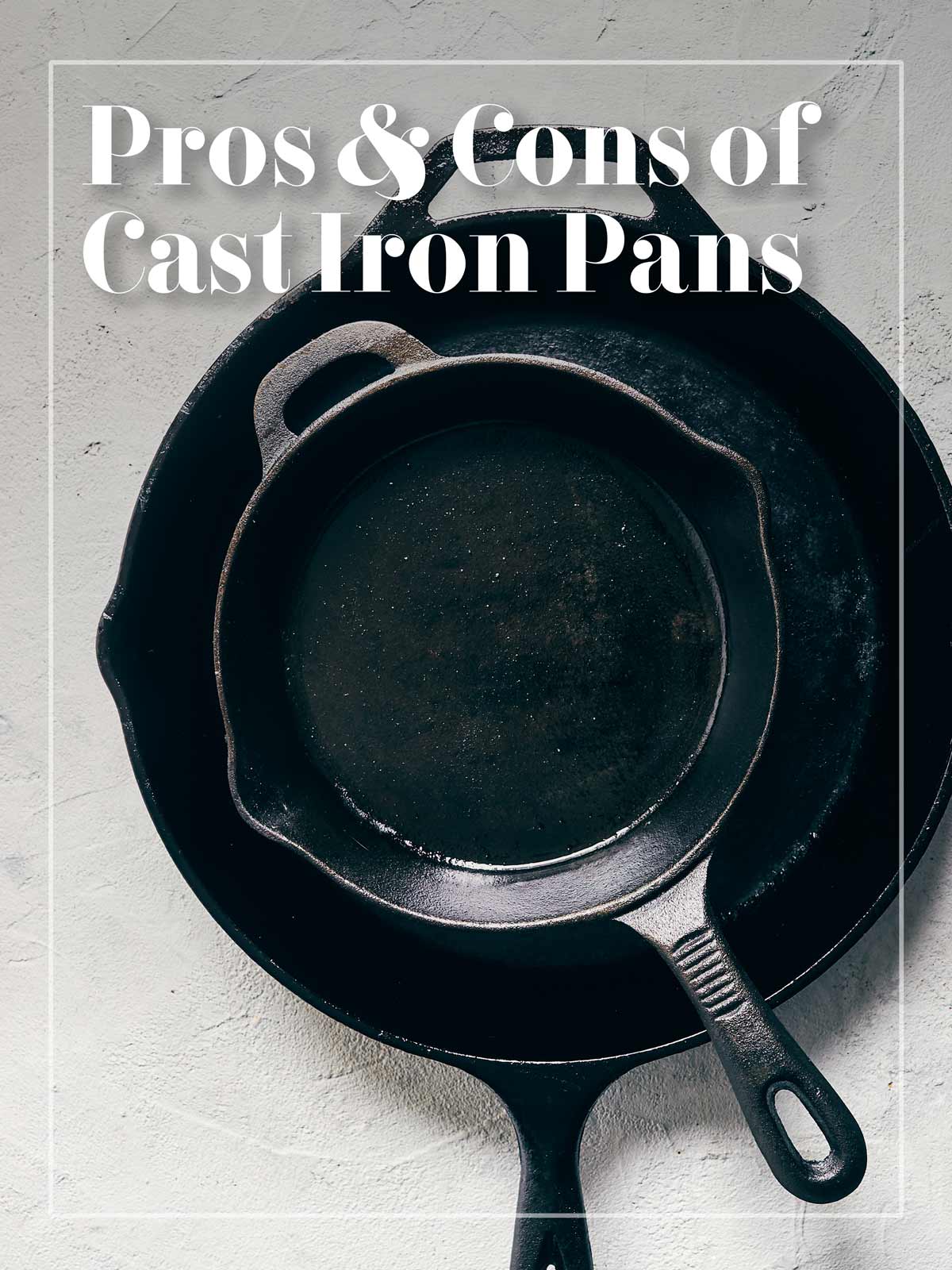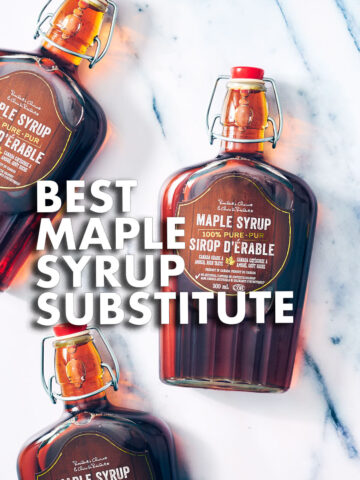A cast iron pan is an iconic piece of kitchen cookware. But like all materials, it has its strengths - and also its weaknesses. Keep reading to get the inside info on the pros & cons of cast iron pans.

The benefits of cast iron
A cast iron pan is a workhorse in the kitchen. Whether it be searing, sautéing, braising or baking, a cast iron pan can handle it all. We use our cast iron pan to make everything from pancakes, eggs, charred veggies and even pizza.
Here are the top four reasons why we love cast iron pans:
- Cast iron pans are durable: In all likelihood, your cast iron cookware will last longer than you do. No joke. The hand-me-down pan from my grandma’s kitchen is by far our favorite. Why? Because cast iron improves with age. And while they don’t quite make them like they used to, cast iron pans are heavy, near bullet-proof kitchen essentials that’ll last you decades.
- Cast iron pans can be inexpensive: In a day and age where it’s easy to drop hundreds of dollars on a knife and even thousands(!!) on a fancy set of pots, it’s refreshing to be able to buy a solid cast iron pan for less than thirty bucks. And remember what we said about cast iron getting better with age? Well, bonus points if you score a deal on an old second-hand pan.
- Cast iron pans retain heat well: Compared to other materials, cast iron is one of the best when it comes to retaining heat. Some metals like aluminum, experience a significant temperature drop when you add food to the pan. Not so with cast iron: once heated, it’ll maintain a fairly consistent temperature, even after you drop a colder item into it.
Why is this even important? Well, a hot pan that stays hot will help create a crisp, brown crust. This is true on the stove top (searing things like tofu or meat), but also in the oven. In fact, if you preheat your cast iron pan in the oven, then toss a fresh pizza on top, it’ll develop that prized crispy crust - no pizza stone required. In short: cast iron is the way to go if you want a nice golden brown sear on your food. And seriously, who doesn’t want that?! - Cast iron pans can deliver non-stick, without the chemicals: When properly seasoned and cared for, a cast iron pan will develop a coating that’ll prevent most foods from sticking. And yes, you can even cook eggs on a seasoned cast iron pan! This makes cast iron a great alternative to chemical-laden non-stick finishes. Now, before you go shouting from the rooftops...we’re going to give it to you straight: a well seasoned cast iron will come close to a non-stick pan, but it’s not going to be more non-stick than a chemical like Teflon. Teflon is a synthetic resin specifically developed as a nonstick coating. So while it isn’t more non-stick than Teflon, a well seasoned cast iron is often non-stick enough for you to substitute it on most occasions.
The disadvantages of cast iron
We think the benefits significantly outweigh the downsides of a cast iron pan, but as with all materials, it’s not perfect either.
Here are four downsides of cast iron - and what to do about it:
- Cast iron pans are poor conductors of heat: Without getting too nerdy here...a cast iron is good at retaining (keeping) heat, but it isn’t as good as conducting (transmitting) heat. A cast iron pan will heat unevenly if you’re using a burner that’s significantly smaller than the pan itself. In this case, the section of the pan that sits directly over the burner will get much hotter than the edges of the pan (which are farther from the burner).
What to do about it: To avoid uneven heating, use a stovetop burner that’s as similar in size to your pan as possible. And, give the pan enough time to heat up properly. Alternatively, letting a cast iron pan heat up in the oven is another way to ensure even heating.
- Cast iron pans are heavy: These pans don’t pack light. Most cast iron pans are quite heavy, which can make them slightly awkward to maneuver. We need two hands to lift ours in and out of the oven, and because of their size and weight, it helps to have a sink big enough for cleaning it. Keep this in mind when deciding on the size of your pan.What to do about it: While it can be tempting to get the biggest pan possible, opt for a size that’s big enough for your everyday cooking - but also manageable enough that you’ll actually want to use it regularly. Feel out the pans out at the store and see what you’re comfortable with. Remember, that’s the pan’s minimum weight: it’ll be heavier once you load it up with food!
- The handles on a cast iron pan can get very hot: Since cast iron pans are literally cast from a single piece of metal, the handle eventually gets quite hot. This is especially true if the pan has been heating in the oven. Grabbing the handle with your bare hand - in a temporary lapse of judgement - will result in a painful burn. Ouch. What to do about it: Always exercise diligence when dealing with a cast iron pan (or any pan for that matter). We use oven mitts to lift the pan out of the oven, and once we’re done cooking, we’ll drape a dish-towel over the handle as a mental reminder that it’s still warm. You could buy a cast iron skillet handle cover, but frankly, we haven’t taken the plunge. Cook’s Illustrated did an in-depth review here, and the conclusion was that even the winning option should be used like a pot holder. In other words, you can slip it on just when it’s time to remove the hot pan from the stove, but don’t keep it on during cooking or baking. Since we often need two hands to remove the pan from the oven, for us, this solution would at best replace one (of two) oven mitts.
- Cast iron pans require seasoning: In order for your pan to become non-stick, you need to help it build up a layer of seasoning. While many cast iron nowadays are sold “pre-seasoned”, we find that the manufacturer’s seasoning still needs a bit more oomph to get to the “non-stick” level you’d expect. Thankfully, if you know what to do, it’s not hard to build up enough seasoning to start cooking things like eggs on it. Early on, when you’re still building up a good base of seasoning, the pan will be more susceptible to rusting and interacting with acidic foods (like tomatoes and lemon juice). Acidity can work against the seasoning you’re trying to build up and also potentially impart a metallic taste to your food. But once there’s been a good level of seasoning has been built up, you don’t need to worry so much about acidic foods in the pan. In the meantime, it’s best to avoid it.
What to do about it: Take the time to help build up a good base of seasoning in your new pan. And, to help keep that seasoning in-tact, take care when cleaning your pan so that you don’t strip away the seasoning you’re working to build. For all the details on cast iron seasoning, read this article: “How to Season A Cast Iron Pan”.





LEAVE A COMMENT